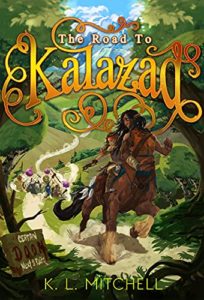An Interview with K. L. Mitchell
 2021 Debuts author K. L. Mitchell has achieved a publishing dream: K. L.’s debut novel, The Road to Kalazad, was released on May 6 from Desert Palm Press. The story about “wandering adventurers almost as good at getting out of trouble as they are at getting into it” has been called a “quirky treat” with humor that is both “appealing and refreshing.” And the cover (see below) is amazing. The book is first in what looks to be a series, and K. L. is hard at work on the next one as we speak, and I’m certain fans are chomping at the bit for it to see the light of day! Like all the authors I’ve featured on my site, K. L. has other responsibilities besides writing, so I’m grateful for the time she took to answer my questions thoughtfully.
2021 Debuts author K. L. Mitchell has achieved a publishing dream: K. L.’s debut novel, The Road to Kalazad, was released on May 6 from Desert Palm Press. The story about “wandering adventurers almost as good at getting out of trouble as they are at getting into it” has been called a “quirky treat” with humor that is both “appealing and refreshing.” And the cover (see below) is amazing. The book is first in what looks to be a series, and K. L. is hard at work on the next one as we speak, and I’m certain fans are chomping at the bit for it to see the light of day! Like all the authors I’ve featured on my site, K. L. has other responsibilities besides writing, so I’m grateful for the time she took to answer my questions thoughtfully.
Christina: The Road to Kalazad is categorized as science fiction and fantasy. What about the genre calls to you? Have you always written that genre? Did you ever contemplate a different version of the book written as realistic fiction?
K.L.: I think the thing about sf/f is that it provides such rich opportunities for holding up a sort of funhouse mirror to the real world and gives us new ways of thinking about ourselves and the society we live in. Almost as long as people have been telling stories, we’ve been inventing fantastic worlds to talk about different aspects of the real one. You can think of Swift and his Gulliver’s Travels, or Spenser’s The Faerie Queene. Or more recently the original Star Trek series, for example. Plus, there is something fascinating about creating a new world, one where different rules apply, and then working out what kind of a world it becomes as a result. As a writer that is very satisfying.
That being said, I have written in other genres. Humor of course is my main interest, and I used to write humorous columns for local publications. I’ve also tried my hand at cosmic horror, having always had a considerable interest in Lovecraft’s works, but I think that still falls under the general umbrella of “weird” fiction.
I can’t say I ever really thought of doing a more realistic version of the book, mostly because the two characters were fully-formed pretty much from the beginning, and when one of your leads is a centaur, you’re not exactly going to end up with Eat, Pray, Love. Besides which, I had some things I wanted to do that were specifically focused on the high fantasy genre, and I wanted to play with those ideas some. So the world more or less formed itself as a playground for me to run these characters around in and have a little fun with those ideas.
Christina: The novel follows the (mis)adventures of Revka and her girlfriend Iyarra, a centaur. They exchange banter like a well-oiled machine. Did someone from real life inspire this pair? How did you decide which dialogue worked and which might just be over the top?
K.L.: I suppose I can admit that Revka is at least partially a satire on myself. Actually, she’s rather more extroverted than I will ever be, but she can be cocksure and just a little too impressed with herself sometimes. Iyarra is more inspired by a friend of mine, who is a very quiet, very shy person but also extremely sensible and wise. As to the dialogue, I really do sweat that part, it being one of the hardest things to get right. The main thing I do is, when going through my many read-throughs and revisions, I like to read all the dialogue out loud. I try to do so as naturally as possible, as if I were acting out a radio drama. And all the time I’m doing that, I’m listening for anything that sounds awkward or doesn’t quite work. I’ve noticed that very often I’ll stumble over a bit if it’s not what it should be, or I’ll say it a different way than it’s written. That’s a big hint to me that it’s time to go back and have another look. If I can go through it smoothly, and it has the right sort of rhythm and flow that I’m listening for, then that’s when I know I’ve got it.
Christina: I’m always amazed by the creativity found in character names. Do you have a process for naming your characters, and do the names mean something to you? Have you ever had to rename a character because you eventually realized the name didn’t fit the character?
K. L.: I generally have some idea of how the character is as I start to flesh them out, but no real hard-and-fast rules for how to come up with the names for them. Actually, very often it comes to trial and error; I imagine the character, put them through their paces, and try out the different names, sometimes even down in the manuscript itself. Sometimes just a plain name will do, other times it has some sort of meaning in-world. For example, Revka is basically the Hebrew version of the English name Rebecca. I just rather liked the sound of that, so I went with it. Iyarra’s people, on the other hand, have a whole elaborate naming tradition, with her own name coming from her mother’s side. Their herd has very lyrical sounding names for women, whereas her father’s people, being hunters and fighters, tend to have blunter, more fricative-based names. There’s a whole thing in my world bible explaining centaur names and their meanings, most of which will never see the light of day, but it gives me a solid foundation to build on. On the other hand, I have another book in the works, where I’m still not sure what the leading character’s name is going to be. I know the kind of name they should have, but I haven’t found one that really fits just yet. So it is definitely a process.
Christina: You’ve worked with computers most of your life, including as a programmer. What has working with computers taught you? Do any of those lessons help you with writing? Is the creative process used for programming similar to that used for writing in any way?
K. L.: That’s an interesting question, and I think it does bring up the important point that while software development is looked on as a primarily logic-based task, it does require a lot more use of the creative mind than many people realize. You’ve really got to be able to let your imagination fly around a problem, taking it apart and coming up with a way to take care of it. It really does engage both sides of the brain, especially when you’re tasked to come up with something new. It’s really no surprise that programmers tend to be interested in creative pursuits: not just writing, but music and drawing and anything that lets a creative mind cut loose for a while.
There are also some surprisingly practical aspects too. One of the main maxims of computer programming is, when taking on a complicated task, break it into smaller tasks and then break those up as needed, until you’ve got something you can deal with. Kalazad is my first successful attempt at writing a novel, and I found that breaking the book down into smaller “beats” and working them out meant that I was actually able to get the thing done. The first couple of times I sat down to write a novel, I had very little in the way of a plan mapped out, and both attempts petered out, mostly because I was just overwhelmed at the scale of the thing. Doing long-form fiction the first time can be very intimidating, so approaching it like a major software project really did help me across the finish line.
Christina: Everyone’s journey to publication differs. Would you mind sharing a bit of your story?
K. L.: Certainly. I made some decisions early on, first that I would divide my attention equally between literary agents and LGBT-owned presses. The thinking was that if I could find an agent, that would be well and good, but at the same time, I really felt that I would be more comfortable with my story in the hands of people who knew where I was coming from and more likely to be sympathetic to my characters. Plus, I really like the LGBT publishing world and it’s a community I wanted to be a part of. I did my homework, pulling up plenty of agents and companies as you do, then put them all into a a spreadsheet and just started working my way down the list, one at a time. I was alternating between agents and small presses, basically, and went about a dozen entries down the list before I landed with Desert Palm last August. From there, there was the process of doing the edits, going back and forth with my editor as we tightened up the book and got it shipshape. Then the company got me in touch with Rachel George, the very excellent artist who did our cover, and we just clicked immediately. It was one of those “this person gets it” moments, and I consider myself very lucky to have her on board. The process of watching the cover come to life through multiple iterations was fascinating, and the end result was better than I could have hoped for.
After all that, we spent some time assembling all the extra matter: acknowledgements, the blurb for the back, that sort of thing. All the stuff you never rally think of when writing the book. So many little details here and there. And then, one day, the printer’s proof shows up in your mailbox and you’re holding your book for the first time. That really drives it home, that moment. (Of course, then you have to go all through it yet again and of course there’s still more errors that have crept in. In the programming world we say “there is always one more bug,” well, in publishing there’s always another typo.) After that, it’s pretty much time to roll up the sleeves and dive into the next book.
I might add that when I got signed on, I started a weekly blog over on my Facebook account, in which I detailed the publishing process. So if any of your readers are interested in how all that goes, they can check that out here.
Christina: According to your website, you’re a joke-teller. So, I have to ask: What’s the best joke you’ve heard? Do you make up your own jokes? What’s that process like?
K. L.: I think my favorite joke is actually a whole bit done by Spike Milligan and Peter Sellers in the radio series “The Goon Show.” It’s known as “What time is it, Eccles?” and it’s a masterpiece of absurdist humor. He takes all the rules of humor: undermining expectations, slipping into new contexts, following illogic in a logical manner, and just plain silliness, and stitches them together into a really amazing bit. It has these two rather dim characters discussing the fact that one of them has the time written down on a piece of paper so he won’t forget it, only to discover that the paper isn’t ticking, so it must be defective. I can’t do the bit justice here, so I’ll just point you to a link.
As to how I create my jokes: a lot of my humor in the book is character-based. The girls are more than a little inspired by the Bob Hope/Bing Crosby “Road to ___” movies, where the characters were distinctly anything but heroic. So it’s fun to take them and put them into these absurd situations and see them try to deal with them. I also love subverting expectations, setting up one thing and then having it veer wildly in another direction. I am always asking myself how I can take what is expected and turn it upside down.
Christina: What does literary success look like to you?
K. L.: Good question, and not one I’m sure I have an answer for. I suppose that so far my definition would have been to get a novel finished, find someone willing to publish it, and see it out the door. And indeed, having these things happen has been very gratifying. But now I find myself wanting to push myself further. I want to see if I can make a series out of it, maybe branch out, get some other books going. I suppose the ultimate goal would be to make enough out of writing to make it my full-time profession. I don’t know if that will ever be the case, but it is certainly something I can work toward. In the meantime, though, I can call myself a published author, and that’s all the success I need.

K. L. can be found in multiple places!
Website: http://klmitchell.me/
Facebook: @KLMitchellHere
Instagram: @k.l.mitchell.author
Thanks to K. L. for agreeing to this interview! If you know of an author who’d like to be featured in an interview (or you are an author who would like to be featured), feel free to leave a comment or email me via my contact page.
